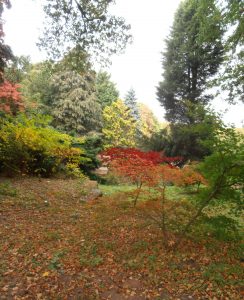November visit to Nottingham High School
On Friday 23rd November 2018 twenty two of our group members met at The Nottingham High School on Waverly Street. We met Kamala, the development officer, who took us to a seated hall here we met one of the ex head teachers. He gave us an interesting lecture on the history of the High School covering five hundred years, illustrated with photos of the original school and the present one with its new additional buildings, which are very impressive. We then had a walk covering the reception frontage, the War Memorial, the John Player Music Hall, the Quadrangle and other buildings were pointed out to us. Then we walked through the main dining area to the latest Junior School where we posed for a photo. We are fortunate to have such a marvellous school as this in our city providing a high standard of education and over the years some very influential people have studied here.
We enjoyed the trip and I have had some good feed back from members, which justify it as another city treasure. Regards Len Marsh.
October visit – Highfields Leisure Park and Lakes
A group of fourteen members met in the Council House Arcade at 11.00 am Friday on 12th October 2018. We then took a tram to Highfields where we alighted and made our way to the Lakeside pavilion. From here we started our circular walk of the lake. It was a wet and windy day but undeterred we continued, observing Herons, Coots, Moorhens and various other birds. At the halfway point we crossed the famous stepping stones to move on down the lovely avenue of different species of trees to the principle entrance to the park. Here the iron railings and pillars have been replaced to the original designs. I gave a short talk at the croquet club. Then we moved onto the lakeside for a group photo and a browse over the new Chinese lions at the waterside. We continued around the lakeside until we arrived back at the pavilion café were we all took refreshments, after which I took the group to the recital hall for a lunchtime concert. This featured a selection of jazz standards and original compositions by teachers and lecturers from the university, a really first class group of musicians. This brought our day to an end but everyone had enjoyed the trip. Thanks to Sir Jesse Boot who paid for this park to be set up, and recently the National Lottery Funded project for the park restoration in 2017-18 of £4.8 million pounds. Well worth a visit. Len Marsh.
September visit – Nottingham City walks 5 + 10.
On Wednesday 12th September 2018 a group of nineteen members met at Canning Circus in Nottingham to cover the above walks. Firstly I gave a short talk on the surrounding area, then we moved onto The Ropewalk, and detouring round the old police station, we joined the pathway which gave us views overlooking the park, with it’s host of most interesting houses and buildings, until we reached the tower house at the end of the road. We then went to observe the original eye hospital building and entrance door on the ropewalk plus the Victorian Royal Mail box set in the wall. We followed round the original General Hospital pointing out features; we arrived at the front of the hospital building with a design similar to that of an amphitheatre. Here the group sat a while whilst I told them of the hospital’s history with the five storey circular wards and the original chapel. Next we viewed 76 James Street where Lord Byron had a short stay, it is now being renovated and is privately owned. On Postern Street we browsed over the historical boundary posts and then to Standard Hill and the spot where King Charles 1st raised the standard to mark the civil war. After a talk we moved onto the nurses home, Memorial House, the frontage is undergoing a clean up and stands proud, credit to our city. Then we went onto Severns House, and next Castle Gate and the famous Newdigate House, then we moved across to St Nicholas Church to tie in with the civil War. Next onto the Royal Children, Castle Gate and Salutation pub in Hounds Gate. I was able to relate information at each of these points. Following down we noted the Bridge of Sighs, which connects the large old buildings on both sides of the road built for James Snook. Snooks drapers were one of Nottingham’s largest companies in 1891, now they are mainly private apartments. Lastly we went to Wheeler Gate we visited Eldon Chambers courtyard and learnt about the Oriental Café, which has a history. To sum up the group enjoyed our tour, we all found it very interesting and big thanks to the U3A members who compiled the files of information. Len Marsh
August visit – Nottingham the Watson Fothergill buildings.
A group of twenty one members of City Treasures met in the Council House Arcade on Wednesday 8th August 2018 to carry out the Walk 7 -Watson Fothergill trail, researched and compiled by Margaret Naylor, Pat Collins, Denise Watts, and Diana Pidgeon of the Discovering Nottingham Group to whom we are grateful for the information in the book.
Watson Fothergill was without doubt an architectural giant as we can all see in our city. After giving a talk on his life and achievements we touched on the sadness of the demise of the Black Boy Hotel. Then we paid homage to the little green plaque on the wall of Primark, most of us were unaware of its existence, also it is hard to believe how the city could demolish one of Watson Fothergill’s masterpieces and replace it with an uncharacteristic concrete block.
We studied four buildings then had a refreshment break before continuing onto four more. As it states in the book his designs were to make you look up and this we did much to our own pleasure, once again we have seen some wonderful city treasures and I feel fortunate that I have shared this great architects achievements with my group. Len Marsh Walk Organiser.
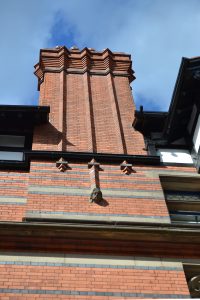


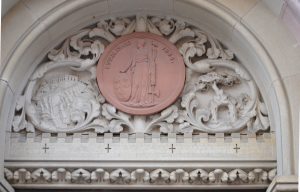
July visit to the City of Lincoln
A group of members met at Nottingham Midland Station on Wednesday 11th July 2018 and took the train to the City of Lincoln Station, from here I took them by bus to the Lincoln Hotel. After a short walk to the Information centre we purchased tickets for a tour of the cathedral and castle, but first a cup of tea in a quaint teashop, then onto the cathedral.
Well it is one of the biggest examples of gothic architecture in this country and I must say when you first confront the building its very inspiring, I never imagined it being so big and absolutely beautiful both internally and externally. Next we moved onto the castle and the first thing that draws your attention is the massive medieval wall surrounding it. Within the grounds are Lincoln Crown Court and also the Victorian prison which we visited containing a vault housing the Magna Carta. Then we joined a guided tour around the grounds for a very good history lesson on the castle, our thanks to Barney for that.
Next we walked down the appropriately named Steep Hill and enjoyed the little antique shops. We continued down to the High Street and then branched off to Brayford Pool where we all took refreshments. Afterwards we made our way back to the station for our return journey. My summary was this is a very historical city with plenty to see and offer, we must return to see some more of it again, an interesting day had by all of the group. Len Marsh.




June visit to Nottingham University Park
A group of eighteen members met in the Nottingham Council House Arcade for our tour of Nottingham University Park. We took the tram to Highfields where we alighted and walked to the Lakeside Arts Centre. From here we commenced our tour moving on into the park and grounds and a brief look into the Keighton Auditorium to observe the modern lecture hall then onto Cripps Hall and the foundation stone laid by the family in 1957 for the students accommodation. Moving on we walked down a lovely Copper Beech tree lined avenue where we saw a new modern style Cripps student health centre being built. Further on we came to the historic Lenton Hurst house built for William Player, the younger son of tobacco magnate John Player. It has a lovely sunken garden backdrop designed by Gertrude Jekyll in 1911. Further on we came to The Downs, a grassy wildflower meadow surrounded at its edges by a wonderful variety of species of native and other trees from around the world. We stopped here to admire the view and I also gave a talk relating to the university’s history and also naming famous people who have given lectures here like Albert Einstein, Mahatma Gandhi, H. G. Wells, and our local man D. H. Lawrence.
Next we looked at the oldest building on the park, Lenton Hall, now part of Hugh Stewart Hall. William Stretton designed this house in a pseudo gothic style embellished with battlements and turrets, also on the west side there are dummy windows made to avoid tax in that time period. At the back the lawn drops away to a circular garden surrounded by a flowered rockery and a colourful red Acer tree. We followed a narrow footpath to enter the main library with not so many books but screens and electronic technology to help with research, how times have changed! Then we moved onto The Millennium Garden, a proper showpiece with many eye-catching designs. My favourite is a stone sculpture called Flayed Stone, hand carved from a single piece of glacial granite. Further on we saw Highfields House and went into the walled garden. After viewing the new terraced garden with the ground level fountains we went on to the Trent Building to look at the clock tower and masonry. This park is a treasure to visit, the layout of the buildings does nothing to spoil the landscape and its grounds are truly a scenic area and something we all should be proud of in our city. Len Marsh.


May visit to Midland Station and Historical Pubs
On Wednesday 9th May 2018 the group completed a tour of the Midland Station and some Historical pubs / inns. After meeting up in the Council House Arcade sixteen members caught the tram to the Station Stop where we alighted and I found it to be a good focal point to explain the new tram bridge which crosses over the railway station exactly where the Great Central Railway girder bridge did. It was demolished in the 1980 s, however the new bridge is a Warrun Truss design made of 20″-28″diameter steel tubes is 48 feet wide and 171 feet long, weighs 1,100 tons and has been named” The Karlsruhe Bridge” after Nottingham’s twinned German city. It is a marvellous piece of engineering and future history.
Next we entered Nottingham Midland Station, although we were at the back of the main building I was able to point out the area of the great fire on the 12th January 2018, attended by ten fire engines and costing millions in damage this is still undergoing repairs. The station has served Nottingham for the last 114 years and was opened in 1904 and since the other Victoria Station closed in the 1960s as a result of the Beeching cuts it’s become the city’s main station linked with the tram system.
Nottingham’s first station was Carrington Street opened in May 1839 on the site, which is now the magistrates’ court. The original station gateposts are still sited at the court entrance adjoining the main road.
My summing up of this magnificent Midland Station main building -its architectural qualities are outstanding and the masonry is brilliant, we are truly fortunate to have this lovely building welcoming visitors to our city. We moved onto the first historical pub, The Canal House, with fine canal architecture and two narrow boats moored inside the building. Next we visited the Trip To Jerusalem, set in the sandstone wall with caves linking to our famous castle. Then onto the Salutation Inn where we took a refreshing drink. The landlord took us on a tour of the cellars with an added talk of the inns history. We enjoyed another interesting city tour uncovering some more treasures. Len Marsh.
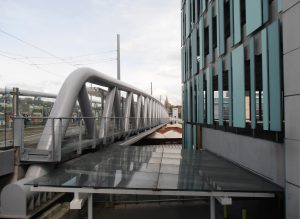




April visit to the Bromley House Library
On Friday the 6th April 2018 a group of fifteen members of City Treasures assembled at Bromley House Library on Angel Row, Nottingham for a guided tour .We were met by a member of staff who took us inside and up three flights of stairs to a seated room where the librarian gave us an interesting lecture on the history of the house and library.
The grade 2 listed Georgian town house was built in 1752 for George Smith, grandson of a wealthy provincial banker who later had financial problems himself and had to sell the house. The library founded in 1816 by a group of Nottinghamshire professional men and set up in Carlton Street, later when Bromley House came up for sale, the library purchased it for £2,750-00 and moved there in 1825.
Today it functions on membership subscriptions but as an independent library gets no statutory funding or grants, it has however received help from the Heritage Lottery Fund, charitable trusts and individual donations over the years. Thankfully the library has an extensive collection built up over its 200 years of history and is one of the few remaining subscription libraries and one of the largest in the U.K. It is also home to one of the few city centre walled gardens.
The moment you enter this house it overpowers you with it’s Georgian architecture and style, with individual rooms each one housing a collection of books of different sizes and catalogued. The main room contains a long case clock that is still set to Nottingham time 4 minutes 33 seconds slower than G.M.T. Also from the main room a self-supporting helix staircase links to the gallery. On the first floor (standfast library) is situated the Meridian Line dating from 1836 to set clocks to noon before Railway time or G.M.T. Outside at the rear is a hidden charming garden peaceful to sit in and enjoy a read on a nice day. The group enjoyed the tour and lecture; I would recommend it to any group. The insignificant entrance door in the heart of the city reveals a true city treasure to all who enter. Len Marsh.




March Victorian Theatre Tour.
A group of twenty-one members met Tuesday 20th March 2018 in the Nottingham Council House Arcade. From there we walked up to the Lace Market Theatre that is situated, hiding in a cul de sac called Halifax Place Nottingham. The listed building has a white ornate original Victorian frontage. In the past it has been used for several different purposes, once it was a chapel then a school attended by the famous William Booth founder of the Salvation Army movement. It has also been a warehouse, but luckily for us the present owners John and Beverley Anthony have worked wonders in the last seven years to restore it back to the lovely Victorian theatre it once was. They and their dedicated team of volunteers continue to revamp areas, this year installing a nice licenced bar and coffee bar. Next on the list is the auditorium flooring and seating. The behind the scenes tour is an interesting journey for everyone, it is hard to realise just how much work the team put into a production for a theatre play, also all the skills involved.
We ended our tour in the cafe / bar for refreshments where John and Beverley answered questions and gave a brief history of the theatre. I hope Eastwood U3A Theatre Group continue to use this classic charming theatre, as it deserves our support. The group enjoyed the tour and we wished them well in the future. Len Marsh.

February Tour of Wollaton Hall
On a snowy Monday morning at 10-30 February 26th, 2018 a group of City Treasures members met in Wollaton Hall car park for a tour of this magnificent Grade 1 listed Elizabethan mansion. It is situated on a natural hill three miles West of the city centre and surrounded by 500 acres of parkland with formal gardens and avenues of trees and an ornamental lake.
Just standing on the steps at the front entrance to the hall you take in a panoramic view of the estate. Often there is a herd of fallow and red deer present in the park. The gentry of the time would have viewed the park from the Prospect Room.
Our guide started the tour in the main hall with a talk about the Willoughby family history then went onto a detailed description of the very decorative room with the gallery and organ also wall displays of rifles and weapons. Next we moved into the basement area with a large steel back door, the servant’s quarters, original bell room and flooring. Then we moved onto the restored Tudor kitchen followed by the abattoir where the game etc was cut up. Next onto a grilled gate and down a brick lined tunnel to the wine cellars and the Admirals Bath, a water storage tank carved out of the rock. It was obvious to us the owners were very wealthy at the time of building but history tells a different story, and later after the house fire, it stood empty for forty years.
I took the group out of the back door of the hall to enable us to see views and details at the rear of the house often missed by many people. Next I showed the revamped Camellia House and then, after following a narrow period pathway we reached the stable block and went into the nature museum with taxidermy display of wild animals and birds etc. There is also a small museum dedicated to the US Airborne unit who camped in the park before the D-Day landings in the Second World War.
The house is now Nottingham Natural History Museum built 1580-1588 for Sir Francis Willloughby and designed by Robert Smythson. He went on to design Hardwick Hall built with Ancaster stone from Lincoln and paid for by coal from local pits. My group enjoyed the tour and I intend another different trip, as there is so much history at Wollaton Hall. Len Marsh.
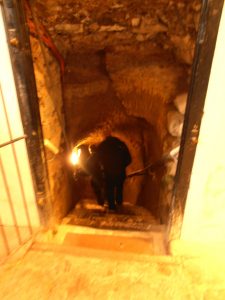


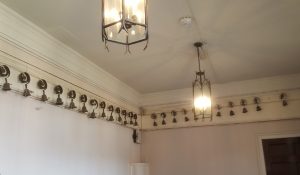
January Film Show about Kimberley Past and Present
On Monday 15th January 2018 a group of twenty-two members met at The Horse and Groom Moorgreen for a film slide show about Kimberley Past and Present.
The old photographs and postcards and the present day photos proved their worth when making comparisons with the old and new situations, and the major changes that have taken place in the Kimberley area in a short space of time.
Wolsey’s factory, a school, a row of shops, public houses, railway bridges, Hardy’s house, The Firs, and the Brewery, to name but a few of the things that have changed the local landscape to some degree, and no doubt further changes will happen like the Nottingham City Tram system, which will reach into Kimberley via the old railway route in the not to distant future.
The group found the film show very interesting it also improved our local knowledge for which we had to thank members Bill Saxton, who presented the show and also our thanks to Margaret Naylor for her kind assistance. Len Marsh.




